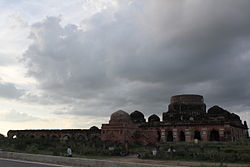Kalpi: Difference between revisions
Apparition11 (talk | contribs) m Reverted 2 edits by 171.20.68.68 (talk): WP:COPYVIO of http://kalpriyanagari.com/kalpi.html. using TW |
D.kpatel2612 (talk | contribs) mNo edit summary |
||
| Line 65: | Line 65: | ||
==History== |
==History== |
||
It is believed that the city was known as Kalak dev ki kalpi in the ancient times, later abbreviated to Kalpi. Kalpi is said to have been founded by King Vasudeva at the end of the 4th century. In 1196 it fell to [[Qutb-ud-din Aybak]], the viceroy of [[Mohammed Ghori]], and during the subsequent Muslim period it played a significant part in the history of central India. During [[Akbar]]'s reign, Kalpi was a governor's seat and had a mint for copper coinage. |
It is believed that the city was known as ==== "Kalak dev ki kalpi" ==== in the ancient times, later abbreviated to Kalpi. Kalpi is said to have been founded by King Vasudeva at the end of the 4th century. In 1196 it fell to [[Qutb-ud-din Aybak]], the viceroy of [[Mohammed Ghori]], and during the subsequent Muslim period it played a significant part in the history of central India. During [[Akbar]]'s reign, Kalpi was a governor's seat and had a mint for copper coinage. |
||
About the middle of the 18th century it passed into the hands of the [[Marathas]]. It was captured by the British in 1803, and after 1806 remained in British possession until India's independence in 1947. Kalpi was a part of [[Bundelkhand Agency]], formed in 1811, and also housed its headquarters from 1818 to 1824. During this period the political agent to [[Governor General of India]] was appointed and headquartered in Kalpi. The [[British East India Company]] made it one of their principal stations for providing "commercial investment". In May 1858 Sir [[Hugh Rose, 1st Baron Strathnairn|Hugh Rose (Lord Strathnairn)]] defeated here a force of about 10,000 rebels under the [[Rani Lakshmibai|Rani of Jhansi]]. |
About the middle of the 18th century it passed into the hands of the [[Marathas]]. It was captured by the British in 1803, and after 1806 remained in British possession until India's independence in 1947. Kalpi was a part of [[Bundelkhand Agency]], formed in 1811, and also housed its headquarters from 1818 to 1824. During this period the political agent to [[Governor General of India]] was appointed and headquartered in Kalpi. The [[British East India Company]] made it one of their principal stations for providing "commercial investment". In May 1858 Sir [[Hugh Rose, 1st Baron Strathnairn|Hugh Rose (Lord Strathnairn)]] defeated here a force of about 10,000 rebels under the [[Rani Lakshmibai|Rani of Jhansi]]. |
||
Revision as of 20:54, 31 March 2014
Kalpi
कालपी | |
|---|---|
city | |
 South facing view of Chaurasi Gumbad | |
| Country | India |
| State | Uttar Pradesh |
| District | Jalaun |
| Elevation | 112 m (367 ft) |
| Population (2001) | |
| • Total | 42,858 |
| Languages | |
| • Official | Hindi |
| Time zone | UTC+5:30 (IST) |
Kalpi is a city and a municipal board in Jalaun district in the Indian state of Uttar Pradesh. It is on the right bank of the Yamuna.
History
It is believed that the city was known as ==== "Kalak dev ki kalpi" ==== in the ancient times, later abbreviated to Kalpi. Kalpi is said to have been founded by King Vasudeva at the end of the 4th century. In 1196 it fell to Qutb-ud-din Aybak, the viceroy of Mohammed Ghori, and during the subsequent Muslim period it played a significant part in the history of central India. During Akbar's reign, Kalpi was a governor's seat and had a mint for copper coinage.
About the middle of the 18th century it passed into the hands of the Marathas. It was captured by the British in 1803, and after 1806 remained in British possession until India's independence in 1947. Kalpi was a part of Bundelkhand Agency, formed in 1811, and also housed its headquarters from 1818 to 1824. During this period the political agent to Governor General of India was appointed and headquartered in Kalpi. The British East India Company made it one of their principal stations for providing "commercial investment". In May 1858 Sir Hugh Rose (Lord Strathnairn) defeated here a force of about 10,000 rebels under the Rani of Jhansi.
Geography
Kalpi is located at 26°07′N 79°44′E / 26.12°N 79.73°E.[1] It has an average elevation of 112 metres (367 feet).
Location and industry
The old town, which is on the Yamuna river, has the ruin of a fort, and several temples of interest, while in the neighborhood are many ancient tombs. Away from the river to the south-east is a lofty modern town ornamented with representations of the battles of the Ramayana. Kalpi is still a centre of local trade (principally in grain, ghee and cotton) with a station on the railway line from Jhansi to Kanpur, which crosses the Yamuna here.
In late 1970s and early 1980s Kalpi was one of the areas in central India affected by dacoits, and was frequented by the much dreaded Phoolan Devi gang. It has been declared an Industrial belt by the Government of India and is known for the handmade paper produced here.
References
- This article incorporates text from a publication now in the public domain: Chisholm, Hugh, ed. (1911). Encyclopædia Britannica (11th ed.). Cambridge University Press.
{{cite encyclopedia}}: Missing or empty|title=(help)
